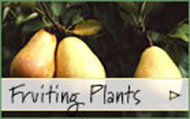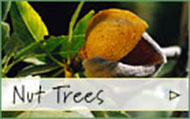|
Summer Planting:A selection of plants are available during summer for shipping, pick up at the farm, and pick up at the Olympia Farmers Market. To view summer plant availability, click the bubble for Summer (July-Oct) at the top of each product page. Summer Drop-in Nursery hours: We are open for drop-ins and plant browsing during the summer! We have a beautiful selection of potted plants available. Some even have fruit on them! Several varieties are in pulp pots to reduce transplant shock and to make summer transplanting a breeze. Staff will be on hand to answer questions and to help you make selections. July - Dec drop in hours: M-F 9:00am to 4:00pm and Sunday 10:00am to 3:00pm. We are closed on Saturday. Olympia Farmers Market: Orders can be placed on our website, via email or phone. We sell at the Olympia Farmers Market every Saturday and Sunday 10am-3pm, April through December. We also sell on Thursdays and Fridays from April to Oct 31st. We will notify you when your order is pulled and ready for delivery to the Market. Shipping Summer Plant Orders: During the summer, the shipping costs are higher because the plants have to be shipped in pots. Summer shipping is not available to AL, AR, CT, DC, DE, FL, GA, KY, LA, MA, MD, ME, MI, MS, NH, NJ, NY, OH, PA, RI, TN, VA, VT, and WV. Orders that are shipped in summer are not guaranteed. For shipping non-plant items please follow the bare-root Winter/Spring shipping chart
Summer Shipping Chart (July - October) Shipping to WA, OR, ID and CA (via UPS). Please provide a UPS address. Merchandise Total: $0.01 - $30.00.......$23.95 Merchandise Total: $30.00 - $50.00.......$25.95 Merchandise Total: $50.01 - $80.00.......$29.95 Merchandise Total: $80.01 - $100.00 ... $38.00 Merchandise Total: $100.01 - $200.00 . add 40% Merchandise Total over $200.00 ........... add 30% Shipping to All Other States (via UPS). Please provide a UPS address. Merchandise Total: $0.01 - $30.00.......$35.00 Merchandise Total: $30.00 - $50.00........$42.00 Merchandise Total: $50.01 - $80.00........$50.00 Merchandise Total: $80.01 - $100.00 ..... $60.00 Merchandise Total: $100.01 - $200.00 ..add 50% Merchandise Total over $200.00 ........... add 40% Alaska and Hawaii - please contact our office for a shipping quote.
|
Summer Planting:A selection of plants are available during summer for shipping, pick up at the farm, and pick up at the Olympia Farmers Market. To view summer plant availability, click the bubble for Summer (July-Oct) at the top of each product page. Summer Drop-in Nursery hours: We are open for drop-ins and plant browsing during the summer! We have a beautiful selection of potted plants available. Some even have fruit on them! Several varieties are in pulp pots to reduce transplant shock and to make summer transplanting a breeze. Staff will be on hand to answer questions and to help you make selections. July - Dec drop in hours: M-F 9:00am to 4:00pm and Sunday 10:00am to 3:00pm. We are closed on Saturday. Olympia Farmers Market: Orders can be placed on our website, via email or phone. We sell at the Olympia Farmers Market every Saturday and Sunday 10am-3pm, April through December. We also sell on Thursdays and Fridays from April to Oct 31st. We will notify you when your order is pulled and ready for delivery to the Market. Shipping Summer Plant Orders: During the summer, the shipping costs are higher because the plants have to be shipped in pots. Summer shipping is not available to AL, AR, CT, DC, DE, FL, GA, KY, LA, MA, MD, ME, MI, MS, NH, NJ, NY, OH, PA, RI, TN, VA, VT, and WV. Orders that are shipped in summer are not guaranteed. For shipping non-plant items please follow the bare-root Winter/Spring shipping chart
Summer Shipping Chart (July - October) Shipping to WA, OR, ID and CA (via UPS). Please provide a UPS address. Merchandise Total: $0.01 - $30.00.......$23.95 Merchandise Total: $30.00 - $50.00.......$25.95 Merchandise Total: $50.01 - $80.00.......$29.95 Merchandise Total: $80.01 - $100.00 ... $38.00 Merchandise Total: $100.01 - $200.00 . add 40% Merchandise Total over $200.00 ........... add 30% Shipping to All Other States (via UPS). Please provide a UPS address. Merchandise Total: $0.01 - $30.00.......$35.00 Merchandise Total: $30.00 - $50.00........$42.00 Merchandise Total: $50.01 - $80.00........$50.00 Merchandise Total: $80.01 - $100.00 ..... $60.00 Merchandise Total: $100.01 - $200.00 ..add 50% Merchandise Total over $200.00 ........... add 40% Alaska and Hawaii - please contact our office for a shipping quote.
|









